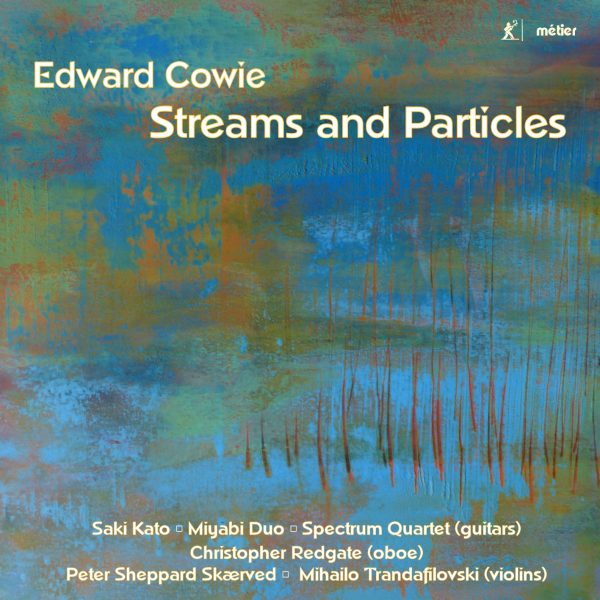Fanfare
Edward Cowie is an English composer, born in Birmingham in 1943, who spent most of his early life in the rural countryside. Phillip Scott, in a Fanfare 40:1 review of three of Cowie’s string quartets, referred to his “kaleidoscopic changes of perspective.” That is quite fitting for the music on this disc, too, which keeps shifting colors regularly. Cowie is clearly influenced by the Impressionists and Messiaen, but he stretches musical boundaries quite a bit more. In his notes accompanying this CD, which is titled Streams and Particles, Cowie says that the album “has several points of focus ranging through Particle Physics, the meditations of a classical Japanese mystic and poet, the flow and flux of a lovely stream in Wiltshire, England, and the paintings and writings of one of the founders of ‘Abstraction’ in Fine Arts: Wassily Wassilyevich Kandinsky.” The disc is structured so that the three central pieces are scored for guitar (solo, duo, and quartet). The first piece is for two violins, the last for solo oboe.
Cowie’s detailed notes and accompanying illustrations explain the inspiration for each work and the connections between them. Stream and Variations for solo guitar was commissioned by the great guitarist Julian Bream (though not for him to perform, as he had retired by 2019) and was inspired by the River Sem near Bream’s home. The variations alternate between what Cowie calls “pools” and “runs,” reflecting what he observed when walking along the same pathways that Bream had. There were two distinct conditions of moving water: pools of limpid, slow-moving water and runs of narrow streams into which the water tumbled. Each piece on the program has a distinct, close connection to whatever inspired it, all thoroughly described by Cowie. For example, Basho Meditations for guitar duo is informed by eight one-line haikus by the ninth-century Japanese classic poet Basho.
The issue for listeners, though, is how the music stands up on its own. For me, it did hold interest because of its widely varying colors. The music is Pointillistic in nature; there is little that would qualify as a melody. But Cowie has a fine ear for color and texture, and he also gives shape to the music through a carefully designed rhythmic ebb and flow. Contrapuntal textures are important in his music, and he veers back and forth between tonality and atonality. In his own words, “I decided to fuse tonality and atonality in a kind of meltdown of harmonic procedures.”
Cowie’s musical language is strongly influenced by his interest in physics, painting, and Nature. He writes music that requires close attention and an openness to unusual effects. Particle Partita was commissioned by experimental physicist Brian Foster of the University of Oxford. The two violinists work in tandem; Cowie’s idea is to mirror the reception of knowledge from one generation by the next, and then new knowledge passed on to the future. Thus each of its first seven movements is interrupted by a second player before the first has finished.
This is the kind of music usually only performed by artists who are deeply committed to it, which explains the excellence of the performances here. My own appreciation grew the more I listened, and in the end Ifound an almost hypnotic attraction had set in.
@divineartrecordingsgroup
A First Inversion Company
Registered Office:
176-178 Pontefract Road, Cudworth, Barnsley S72 8BE
+44 1226 596703
Fort Worth, TX 76110
+1.682.233.4978










![Listen to the full suite of Marcel Dupré’s Variations Sur un Noël, Op. 20 from Alexander Ffinch’s #Expectations release today! listn.fm/expectations [in bio]](https://scontent-dfw5-1.cdninstagram.com/v/t51.71878-15/588904367_2327488161082898_8709236950834211856_n.jpg?stp=dst-jpg_e35_tt6&_nc_cat=105&ccb=7-5&_nc_sid=18de74&efg=eyJlZmdfdGFnIjoiQ0xJUFMuYmVzdF9pbWFnZV91cmxnZW4uQzMifQ%3D%3D&_nc_ohc=H8WFKm530VcQ7kNvwGIamXN&_nc_oc=AdkCU0bHzQ_0XTKomMoPppVnXnL1o2Frx1p2Wu6t5LBXNQzH6Wl0TsxZ8qP8dary_oI&_nc_zt=23&_nc_ht=scontent-dfw5-1.cdninstagram.com&edm=ANo9K5cEAAAA&_nc_gid=SPTFzkrIOD6SSyDEeWIBtg&oh=00_AflfQX8dJ2PQlRfOf-cE5S6uiLcUQ78cXG8yrNvtzs9pew&oe=695530EA)

![“the ‘Manteca’ Paraphrase – a rare foray into the two-piano medium but here played double-tracked – exudes a panache of which Dizzy Gillespie would surely have approved.… [a] recital well worth investigating.” —Gramophone Magazine with high praise for Ophelia Gordon's debut release, Kapustin: Between the Lines!](https://scontent-dfw5-3.cdninstagram.com/v/t51.82787-15/598796470_18303255136283342_540941604740887837_n.jpg?stp=dst-jpg_e35_tt6&_nc_cat=108&ccb=7-5&_nc_sid=18de74&efg=eyJlZmdfdGFnIjoiRkVFRC5iZXN0X2ltYWdlX3VybGdlbi5DMyJ9&_nc_ohc=IC4zZ7tcpb8Q7kNvwExli9l&_nc_oc=AdkjWertDMestob1858EBfq-ZPSKTc3bZmsrCEnRSML_lEfnhcAUU0oX3XgJxqDYQq0&_nc_zt=23&_nc_ht=scontent-dfw5-3.cdninstagram.com&edm=ANo9K5cEAAAA&_nc_gid=SPTFzkrIOD6SSyDEeWIBtg&oh=00_Afl00CtudigeRGbu5zfgTNYSWA2ZPtxXGEVnkusdBxzBWQ&oe=69550B44)